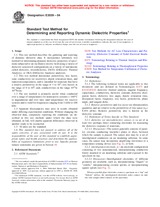Potrebujeme váš súhlas na využitie jednotlivých dát, aby sa vám okrem iného mohli ukazovať informácie týkajúce sa vašich záujmov. Súhlas udelíte kliknutím na tlačidlo „OK“.
ASTM E2039-04
Standard Test Method for Determining and Reporting Dynamic Dielectric Properties (Withdrawn 2009)
Automaticky preložený názov:
Štandardné skúšobnú metódu pre stanovenie a podávanie správ dynamické dielektrickej vlastnosti ( Withdrawn 2009 )
NORMA vydaná dňa 1.2.2004
Informácie o norme:
Označenie normy: ASTM E2039-04
Poznámka: NEPLATNÁ
Dátum vydania normy: 1.2.2004
Kód tovaru: NS-44069
Počet strán: 5
Približná hmotnosť: 15 g (0.03 libier)
Krajina: Americká technická norma
Kategória: Technické normy ASTM
Anotácia textu normy ASTM E2039-04 :
Keywords:
conductivity, dielectric constant, dielectric measurement, dielectric properties, dissipation, loss factor, permittivity, ICS Number Code 17.220.20 (Measurement of electrical and magnetic quantities)
Doplňujúce informácie
| Significance and Use | ||||||||
|
Dielectric measurement and testing provide a method for determining the permittivity and loss factors as a function of temperature, frequency, time, or a combination of these variables. Plots of the dielectric properties against these variables yield important information and characteristics about the specimen under test. This procedure can be used to do the following: 5.2.1 Locate transition temperatures of polymers and other organic materials, that is, changes in molecular motion (or atomic motion in the case of ions) of the material. In temperature regions where significant changes occur, permittivity increases with increasing temperature (at a given frequency) or with decreasing frequency (at constant temperature). A maximum is observed for the loss factor in cases where dipole motions dominate over ionic movement.3 5.2.2 Track the reaction in polymerization and curing reactions. This may be done under either isothermal or nonisothermal conditions. Increasing molecular weight or degree of crosslinking normally leads to decreases in conductivity.4 5.2.3 Determine diffusion coefficients of polar gases or liquids into polymer films on dielectric sensors. The observed change in permittivity typically is linear with diffusant concentration, as long as the total concentration is relatively low.5 This procedure can be used, for example, to evaluate by comparison to known reference materials: 5.3.1 The mix ratio of two different organic materials. This may be determined either through use of permittivity or loss factor values. In early studies, permittivity has been found to be linear with concentration.6 5.3.2 The degree of phase separation in multicomponent systems. 5.3.3 The filler type, amount, pretreatment, and dispersion. This test method can be used for observing annealing and the submelting point crystallization process. This test method can be used for quality control, specification acceptance, and process control. |
||||||||
| 1. Scope | ||||||||
|
1.1 This test method describes the gathering and reporting of dynamic dielectric data. It incorporates laboratory test method for determining dynamic dielectric properties of specimens subjected to an oscillatory electric field using a variety of dielectric sensor/cell configurations on a variety of instruments called dielectric, microdielectric, DETA (DiElectric Thermal Analysis), or DEA (DiElectric Analysis) analyzers. 1.2 This test method determines permittivity, loss factor, ionic conductivity (or resistivity), dipole relaxation times, and transition temperatures, and is intended for materials that have a relative permittivity in the range of 1 to 105; loss factors in the range of 0 to 108; and, conductivities in the range 10 16to 1010S/cm. 1.3 The test method is primarily useful when conducted over a range of temperatures for nonreactive systems (160C to degradation) and over time (and temperature) for reactive systems and is valid for frequencies ranging from 1 mHz to 100 kHz. 1.4 Apparent discrepancies may arise in results obtained under differing experimental conditions. Without changing the observed data, completely reporting the conditions (as described in this test method) under which the data were obtained, in full, will enable apparent differences observed in another study to be reconciled. 1.5 SI units are the standard. This standard does not purport to address all of the safety concerns, if any, associated with its use. It is the responsibility of the user of this standard to establish appropriate safety and health practices and determine the applicability of regulatory limitations prior to use. Specific precautionary statements are given in Section 10. |
||||||||
| 2. Referenced Documents | ||||||||
|




 Cookies
Cookies
